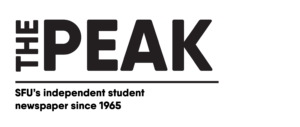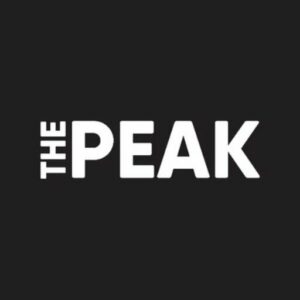By: Lucaiah Smith-Miodownik, News Writer
Editor’s note: As an independent student society, The Peak Publications Society would financially benefit from the General Fee Motion and staff members have been involved in campaigning for it. We’ve taken steps to prevent conflict of interest from affecting our reporting of this issue, such as ensuring the writer and editors of this piece are not involved in or informed by the campaign. The Peak remains committed to objectivity and representing diverse student perspectives on issues that affect students.
As the Simon Fraser Student Society (SFSS) executive election approaches and campaign posters fill campus halls, you may be asking, what even is the SFSS and how does it work? Their website states they are a “a student-led organization” designed to “advocate for students, build student power, and provide resources and services.” All undergraduate students, through paying an activity fee, are SFSS members. Let’s break down what that means, and what we’ll be voting for this Thursday and Friday.
More specifically, the SFSS manages things like student’ health and dental coverage and U-Pass, operates a free legal clinic, and organizes a student food bank program. They also include various committees, which form “to help assist the SFSS Council perform its mandate.” They can either be permanent or ad-hoc, with the latter dissolving “as soon as their task is complete.”
SFSS decisions are run by a Council, which is made up of the executive committee — executive officers elected by the student body, more on them below — and non-executive councillors, which represent “every faculty and departmental student group across all three SFU campuses.” Non-executive councillors also include representatives from equity-seeking constituency groups and other affiliated student groups, like the ones listed in the next paragraph. In conjunction, the executive committee and non-executive councillors “advocate for the interests of the 25,000+ undergraduate students at SFU.”
The SFSS also helps oversee funding for independent student societies and organizations, including the Disability and Neurodiversity Alliance, the Women’s Centre, the Students of Caribbean and African Ancestry, and the First Nations, Métis, and Inuit Student Association.
There are seven executive officer positions up for election this spring, which collectively form the executive committee. Additionally, there are three ballot questions for students to vote on regarding fee increases for student society funding, and increases to the SFSS Health and Dental Plan. Below you will find a brief description of each position, some related past work, the candidates vying for election, and a rundown of the issues on the ballot.
For full-time students, $1.50 extra would be allocated to each of the following societies: Embark Sustainability, Simon Fraser Public Interest Research Group, CJSF 90.1 FM, and The Peak.
President
When necessary, the SFSS president addresses SFU and the public as the figurehead of the organization. Presidential duties include leading executive committee meetings, overseeing executive officers, managing employment contracts, and more. Current president Emmanuel Adegboyega highlighted the cost of living and school budget cuts as high-priority issues at the start of the 2024–25 year.
Candidates for the 2025–26 term:
- Landy Liu: “To be a president who represents you, it is my priority to make you feel heard, included, and recognized.”
- Mehtab Singh: “Push for more student housing and fair rent policies so living near SFU isn’t impossible.”
Vice-president of internal and organizational development
This role oversees the different Council committees, coordinates SFSS meeting logistics, and acts as a conduit between Council and various student unions and groups. They also act as the chair for the governance committee, which “serves as the oversight for the society’s constitution, bylaws, and policies.” During the 2023–24 term, the governance committee focused on finance policies, updating overall Council policy for more inclusive language, and more.
Candidates for the 2025–26 term:
- Viraj Chowdhary: “Maintain regular communication with student unions and constituency groups, ensuring their concerns are heard and addressed promptly.”
- Jeffrey Collinson: “Ensure transparency of the society by submitting work reports to the website in a timely manner.”
- Johnny Gates: “I will work to increase the amount of opportunities students can gain from their time at SFU whether that be career-wise or socially.”
- Ash Powers:“Push for greater transparency around SFSS finances, ensuring students know where their fees are going.”
- Jorawar Singh: “My role, if elected, will be to ensure that the SFSS stays focused on YOU — the students.”
- Thomas-Anei Lueth: Platform not available at the time of writing.
Vice-president of finance and services
This vice-president organizes funds and investments while overseeing the SFSS yearly operating budget. They also chair the finances and services committee. Last year, the committee ensured that SFSS’ tax procedures were up to date, as well as proposed the current year’s Council term budget. The vice-president of finance and services also monitors current finance policies to avoid overspending. They collaborated with the vice-president of internal and organizational development to sign the StudentCare agreement, which focuses on providing comprehensive health coverage and allowing students to make claims for reimbursement.
Candidates for the 2025–26 term:
- Philippe Bamba: “I will fight to reduce student tuition increases to 1% for the coming years by working with the finance department.”
- Pranay Ratan:“Live Budget Tracker — A real-time budget dashboard so students can see where SFSS funds are being spent.”
Vice-president of university and academic affairs
This role acts as a bridge between the Council and the school. They “coordinate student representation on all university committees,” as well as “student involvement in university community affairs and activities.” They also serve as the chair for the university and academic affairs committee. Last year, the committee ran the Munchie Mondays program, providing free snacks to students. It also helped facilitate the Free Breakfast program, and collaborated with SFU to put out a survey regarding student opinion on tuition.
Candidates for the 2025–26 term:
- Rishu Bagga: “I bring a track record of results, strong advocacy, and effective leadership.”
- Brian Nderitu: “Push for open-access course materials, work to integrate textbook costs into tuition fees, and advocate for more scholarships and bursaries.”
Vice-president of external and community affairs
This role connects the SFSS with “external groups and community organizations.” In December 2021, they helped connect with local groups including Highlands Elementary School, Nester’s, Point Church, and more to raise money for flood victims. The position also serves as the chair for the external and community affairs committee. During the 2023–24 term, the committee focused on the Community Fridge program, designed so community members can take and leave food to reduce waste while helping one another. The committee also represented SFU students during the BC budget consultation process, and helped host events like Welcome Day and Valentine’s Day celebrations.
Candidates for the 2025–26 term:
- Jessica Lamb: “Continuing to work with other student-led and student-focused organizations to advance advocacy and lobbying efforts.”
- Chitransh Motwani: “Lobby for lower tuition fees, increased government funding, and more financial aid options for students.”
- Surya Murali: “I will work with the British Columbia Federation of Students and the Alliance of BC Students to push back against unfair hikes, especially for international students.”
Vice-president of equity and sustainability
This position connects the SFSS with “all constituency groups and collectives representing marginalized communities.” They represent SFSS on pressing issues like “disability justice, anti-racism, [and] climate justice.” They serve as the chair for the equity and sustainability committee. Last year, the committee helped with Munchie Mondays, approved a trial run of a Menstrual Product program in SUB bathrooms, and more.
Candidates for the 2025–26 term:
- Hyago Santana Moreira: “For me, the fight for sustainability and equity isn’t just policy — it’s personal.”
- Esther Nguyen: “Making sure that marginalized voices are at the table, not just an afterthought in decision-making.”
- Besmillah Sultani: “SFU should be a place where every student feels included, supported, and empowered.”
Vice-president of events and student affairs
The vice-president of events and student affairs is “a liaison with student unions, constituency groups, clubs, independent student run societies, and other student groups.” This position supervises the process of creating new student unions and constituency groups as well. They also serve as the chair of the events committee. Last year, the events committee coordinated pet therapy on campus, movie nights, Diwali, Holi Hai, and more.
Candidates for the 2025–26 term include:
- Vee Babbar: “We deserve a campus that feels alive — where events are bigger, student life is stronger, and our community is more connected than ever.”
- Yousuf Naroo :“I’ll push for an official student vote to increase social spaces on campus.”
- Mayank Pandit: “Events should be more physically and financially affordable for all students, with affordable tickets and accommodations for students with disabilities.”
- Albert Radu: “I will bring much-needed reform to the financing system to ensure that the distribution of funds is faster, fairer, and transparent to club organizers.”
- Giselle Rafe:- “I’ve dedicated myself to creating spaces where people feel supported, connected, and empowered.”
Referendum ballots
The first ballot measure is a General Fee Motion.
- This involves a proposed fee increase to go towards funding for the following independent student societies: Embark Sustainability, Simon Fraser Public Interest Research Group, CJSF 90.1 FM, and The Peak. The groups state that their levies have not increased to keep up with inflation and this has “limited their ability to serve students and enhance campus life.”
- For full-time students, $1.50 extra would be allocated to each group. Additionally, the fee for SFSS membership would increase by $12 for full-time students. This would be a total increase of $18.
- For part-time students, the fee for each organization listed above would increase by $0.75, and the SFSS membership fee would increase by $6. This brings the total increase to $9.
- Additionally, these fees would increase in proportion with the rate of inflation beginning in the fall of next year.
- Students always have the ability to opt-out and receive a refund for these fees.
The second ballot measure is a Health and Dental One Time Increase.
- This involves a proposed increase in yearly health and dental insurance fees for students. Plans would see an increased cost of $97. For basic plans, this would mean a jump from $207.40 to $304.40. For enhanced plans, the fee of $267.08 would increase to $364.08.
- Without an increase in fees, “the Board of Directors will be forced to further reduce benefits next year and every subsequent year.”
- For students who have other coverage, it is possible to opt-out entirely.
The third ballot measure is a Health and Dental Inflationary Increase.
- This involves allowing for the SFSS Board of Directors to increase health and dental fees by a maximum of 5% per year beginning September 1, 2026.
- This potential increase would be designed “to account for inflation.”
- Without this increase, “Health and Dental Plan services will be cut next year and every subsequent year.”
Hopefully this clears things up just a little bit. Voting will take place between February 27–28 through SFU email. In the meantime, keep looking for that semblance of human empathy, it’s out there somewhere.
For more information on candidates, positions, and ballot measures, visit sfss.ca. For a more in-depth look at ballot measures specifically, visit The Peak as well.
















































